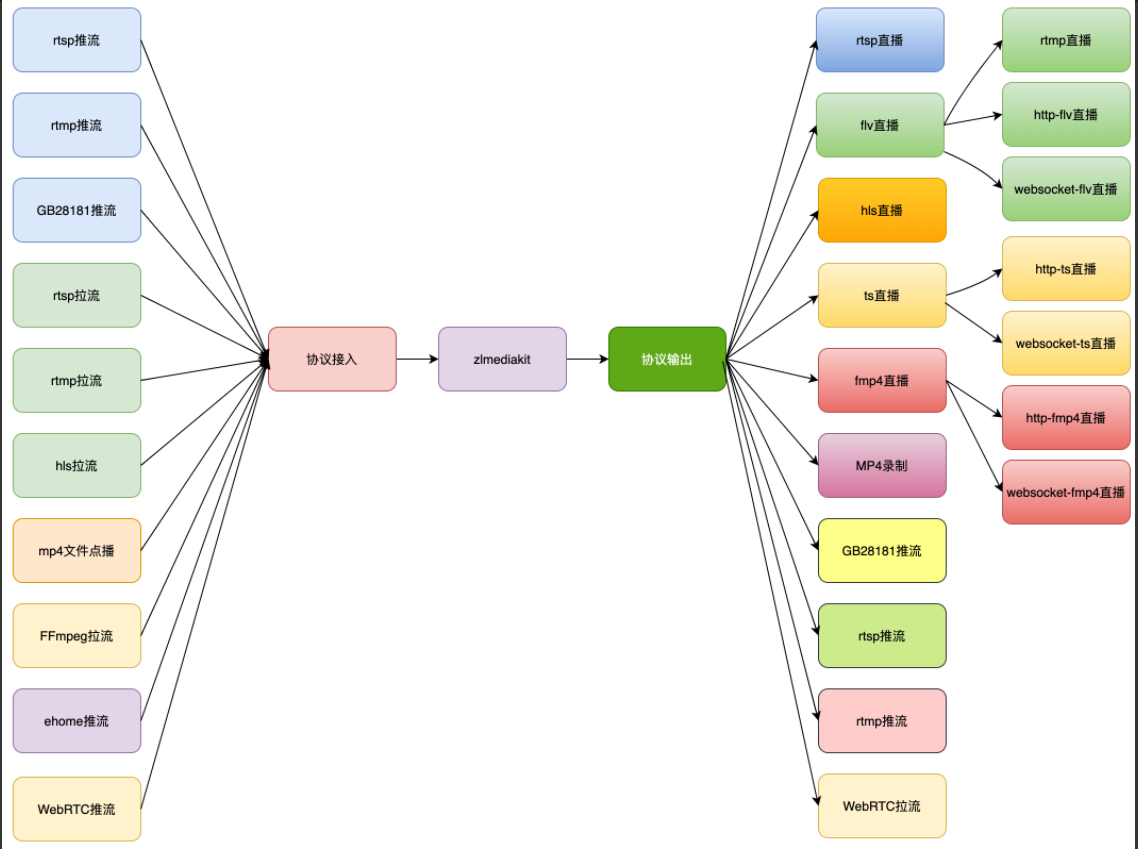The company's project needs to implement a business mechanism that only pushes and pulls rtsp streams. It is said that zlmedia kit can meet the related businesses of rtsp push and pull streams.
Install and understand zlmedia kit streaming media server.
0: learn about its functions from the open source library Readme
Simply know zlmedia kit and understand the basic functions that zlmedia kit can achieve. My understanding is that it is a streaming media server.

1: Zlmedia kit environment construction
Use the linux virtual machine environment to build the environment and start:
#Zlmedia kit adopts the syntax and Library of C++11, and requires the compiler to hold the complete C++11 standard. sudo apt-get install cmake git clone --depth 1 https://gitee.com/xia-chu/ZLMediaKit.git cd ZLMediaKit/ #Be sure to implement git submodule update --init mkdir build sudo cmake .. make -j4 #Related dependent libraries here, test the basic functions first, and only install the openssl library sudo apt-get install libssl-dev #In addition to openssl, others can not be installed #sudo apt-get install libssl-dev #sudo apt-get install libsdl-dev #sudo apt-get install libavcodec-dev #sudo apt-get install libavutil-dev #sudo apt-get install ffmpeg #Generate relevant executable files in the release directory. For the time being, as a test, only focus on the MediaServer main process file hlp@ubuntu:~/ZLMediaKit/release/linux/Debug$ pwd /home/hlp/ZLMediaKit/release/linux/Debug ./MediaServer -h #View related parameters sudo ./MediaServer -d & #start-up #Observe the log and the startup logic is normal
2: Test rtsp, rtmp, rtp push flow and pull flow
As a streaming media server, zlmedia kit uses ffmpeg/obs, ffplay/vlc and other tools as the streaming end or pull end to test the basic functions.
2.1: Test rtsp streaming and pulling: use ffmpeg streaming and vlc/ffplay streaming to test
2.1.1: push the stream with ffmpeg and pull the stream with vlc for testing
Start zlmedia kit and use ffmpeg streaming command:
ffmpeg -re -i "time.mp4" -vcodec h264 -acodec aac -f rtsp -rtsp_transport tcp rtsp://192.168.0.110/live/test #tcp for rtsp streaming
vlc pulls the stream for verification, and it will be found that the playback is normal:

2.1.2: if ffplay is used for testing, try rtsp/rtmp streaming.
Use ffplay to pull flow related commands:
#The default port that should be used here ffplay -rtsp_transport tcp rtsp://192.168.0.110/live/test ffplay -rtsp_transport udp rtsp://192.168.0.110/live/test ffplay rtmp://192.168.0.110/live/test
The related phenomena of streaming are shown in the figure below. It can be found that there is a certain difference in real-time performance between rtsp and rtmp streaming.

2.2: push and pull flow tests using rtmp:
2.2.1: ffmpeg uses rtmp streaming command
-re Indicates that the file is read by timestamp -vcodec vedio Coding format -acodec audio Coding format -f Represents the output format #Streaming command using rtmp ffmpeg -re -i "time.mp4" -vcodec h264 -acodec aac -f flv rtmp://192.168.0.110/live/test
Using vlc to simply test the streaming, the playback is successful. At the same time, it is found that using rtmp,rtsp (udp, tcp rtp mode), the timestamp difference also varies greatly:

2.2.2: if ffmpeg is used for streaming, ffplay is used for streaming test.
#Streaming command using rtmp ffmpeg -re -i "time.mp4" -vcodec h264 -acodec aac -f flv rtmp://192.168.0.110/live/test #ffplay streaming playback command ffplay -rtsp_transport tcp rtsp://192.168.0.110/live/test ffplay -rtsp_transport udp rtsp://192.168.0.110/live/test ffplay rtmp://192.168.0.110/live/test
Briefly compare the timestamp:

2.3: push pull flow test using rtp
2.3.1 rtp streaming using ffmpeg
rtp's push stream and pull stream have some blind spots of personal knowledge, which are temporarily left here
#The command of streaming using rtp: but I didn't test how to play ffmpeg -re -i "time.mp4" -vcodec h264 -acodec aac -f rtp_mpegts rtp://192.168.0.110:10000 #A logic for passing the test: #Logic of rtp streaming with ffmepg and playing based on ffplay: (no server) ffmpeg -re -i time.mp4 -vcodec copy -f rtp rtp://127.0.0.1:1234>test.sdp ffplay -protocol_whitelist "file,udp,rtp" -i test.sdp #You will find that the playback is successful #The following command failed to play successfully, leaving a problem temporarily #ffplay -protocol_whitelist "file,udp,rtp" -i rtp://127.0.0.1:1234
3: Grab the package with wireshark and get familiar with the process:
Simply grasp the package and get familiar with the learning process. Here, rtsp udp is used to push the stream and rtsp tcp is used to pull the stream:
ffmpeg -re -i "time.mp4" -vcodec h264 -acodec aac -f rtsp -rtsp_transport udp rtsp://192.168.0.110/live/test ffplay -rtsp_transport tcp rtsp://192.168.0.110/live/test
3.1: when using ffmpeg for streaming, packet capture is as follows:
OPTION: query the server-side executable method
ANNOUNCE: send media description information
SETUP: create RTSP session
RECORD: request to transfer data
RTP: data push
TEARDOWN: close the session and exit


3.2: the analysis of flow capture process is as follows:
OPTION: query the server-side executable method
DESCRIBE: get the server media description information, usually sdp information
SETUP: create RTSP session
PLAY: request to start data transfer
RTP: data transmission playing
TEARDOWN: close the session and exit

3.3: rtsp push flow and pull flow process summary
Step 1: query the available method option s on the server side
Step 2: interactive media information SDP, streaming: ANNOUNCE; Pull flow: DESCRIBE
Step 3: request to establish a session. Here, tcp based and udp based differential SETUP,
Step 4: trigger to start pushing or pulling. Pushing: RECORD; Pull flow: PLAY,
Step 5: data transmission, but in the opposite direction, the real push stream or pull stream rtp
Step 6: close the session: TEARDOWN
4: Summary
To understand rtsp push-pull flow, practice first and prepare for the future
Test the zlmedia kit streaming server and related push-pull streams.
Next step plan: basic use of obs software (obs is a powerful software. I wanted to try to operate it, but I found it difficult)
Audio and video related theoretical learning and practical reference: Recommended free subscription